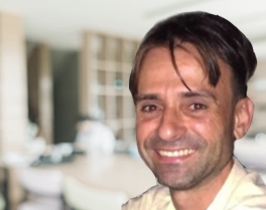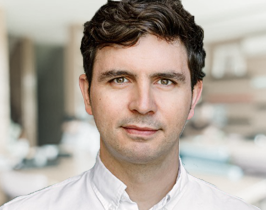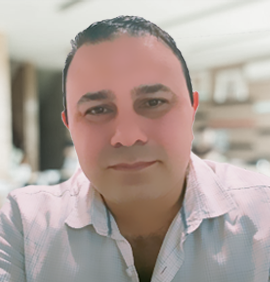 Título da palestra: Aspectos gerais das ferritas em catálise: Aplicação na desidrogenação oxidativa do etilbenzeno/Overview of ferrites in catalysis: Application in the oxidative dehydrogenation of ethylbenzene
Título da palestra: Aspectos gerais das ferritas em catálise: Aplicação na desidrogenação oxidativa do etilbenzeno/Overview of ferrites in catalysis: Application in the oxidative dehydrogenation of ethylbenzene
Resumo da palestra: Spinels ferrites have a chemical structure containing tetrahedral and octahedral sites. Several ferrites are ferrimagnetic and have a wide range of applications, especially in heterogeneous catalysis and photocatalysis processes, in which is possible to extract the post-reaction solid by simple application of an external magnetic field, facilitating its recycling. Ferrites have several interesting chemical properties, due to the presence of acid, basic and redox sites, which are fundamental in heterogeneous catalysis. In addition, they present a low recombination rate of electron-hole pairs which are associated with their low band-gap energy, making these solids promising in photocatalysis. Specifically in the oxidative dehydrogenation of ethylbenzene, ferrites have shown interesting results compared to the traditional hematite-based catalyst due to its higher catalytic stability, minimizing the deactivation by phase change and carbon deposition. On the other hand, many surface reaction aspects still remain an open research field such as the participation of tetra and octahedral sites in the catalytic cycle.
Resumo do palestrante: Tiago Pinheiro Braga obtained a degree in Industrial Chemistry (UFC, 2006, Brazil), masters degree in Inorganic Chemistry (UFC, 2009, Brazil) and PhD degree in Chemistry, Physicochemical, (UFC, 2013, Brazil). He developed the doctoral internship program at IRCE (Institut de Recherche sur l’environnment), Lyon, France (2010-2011). He worked as a postdoctoral fellow in X-Ray Laboratory, Department of Physics, at Federal University of Ceará. He was then hired as an adjunct professor in the Institute of Chemistry at Federal University of Rio Grande do Norte (UFRN), in 2014, which is professor of chemical thermodynamics and chemical kinetics for undergraduate student and professor of heterogeneous catalysis for master and PhD students. He is a member of the postgraduate program in chemistry at UFRN, where he advises master dissertations and doctoral theses. His main research fields are related to chemistry and catalysis such as acid, base and/or redox heterogeneous catalysis; Micro-mesoporous metal oxide and alloys; Catalytic valorization of glycerol and ethanol; Oxidative dehydrogenation of hydrocarbons; Synthesis of carbon nanotubes via CVD and Photocatalysis.
 Título da palestra: A Molecular-Level Interpretation of the Deactivation Mechanisms of Zeolite and Ni Supported Catalysts
Título da palestra: A Molecular-Level Interpretation of the Deactivation Mechanisms of Zeolite and Ni Supported Catalysts
Resumo do palestrante: BSc, MSc and PhD degrees in Chemical Engineering from the University of the Basque Country (UPV/EHU) in 2002, 2004 and 2006, respectively. Hired as Postdoc at TUDelft, Catalysis Engineering department in 2007. After some voluntary work, I received the prestigious Ramon y Cajal fellow in 2009 and tenured to Associate Professor in 2013 at the UPV/EHU. In 2019 I was appointed as Associate Professor in the King Abdullah University of Science and Technology (KAUST), KAUST Catalysis Center (KCC) where I lead the Multiscale Reaction Engineering (MuRE) group. Besides, I have also worked for the Massachusetts Institute of Technology (MIT), University of Western Ontario (UWO), Institute of Catalysis and Petrochemistry (ICP-CSIC) and University of Utrecht (UU).

Título da palestra: Valorização de Resíduos: Relação entre os rejeitos da atividade mineradora e a Catálise.
Resumo do palestrante: Licenciado em Química (2002), Mestre em Química Orgânica (2006) e Doutor em Físico-Química pela Universidade Federal do Pará (2011). Professor Associado 1, desde 2011 é do quadro do Instituto de Ciências Biológicas da Universidade Federal do Pará, onde foi Diretor da Faculdade de Biotecnologia entre 2016 e 2017. Desde a inauguração do Parque de Ciência e Tecnologia do Guamá, em julho de 2016, é vice-coordenador do Laboratório de Óleos da Amazônia, onde se dedica às atividades de pesquisa e prestação de serviços, nas quais atende desde grandes empresas como Agropalma, Natura, Beraca, Amazon Oil e DendeTauá até cooperativas e associações de agricultores familiares. Atua nas áreas de Biocombustíveis e Biomassas Residuais, valorização de resíduos, preparação de catalisadores, além de estudos com óleos e gorduras vegetais e de cianobactérias. Coordena atualmente 2 projetos de pesquisa, entre eles o projeto "DESENVOLVIMENTO DE NOVOS CATALISADORES E PROCESSOS SUSTENTÁVEIS PARA BIORREFINARIA UTILIZANDO REJEITOS AGROINDUSTRIAIS LIGNOCELULÓSICOS AMAZÔNICOS", um dos 15 selecionados (entre 664 propostos) em edital pelo Banco da Amazônia em 2018. Está vinculado aos Programas de Pós-Graduação em Química (PPGQ) e Biotecnologia (PPGBIOTEC). Já co-orientou duas Teses de Doutorado e uma dissertação de mestrado. Além disso, já orientou 3 Teses de Doutorado, 11 dissertações de mestrado e 30 TCCs. Atualmente orienta 4 TCCs, 4 mestrados e 4 doutorados. Tem experiência na área de Química, com ênfase em Cinética Química e Catálise, Química de Produtos Naturais, Oleoquímica e Físico-Química Inorgânica. É membro da Sociedade Brasileira de Química e da Sociedade Brasileira de Catálise.
 Título da palestra: Production of diesel and jet fuel from ethanol
Título da palestra: Production of diesel and jet fuel from ethanol
Resumo da palestra: Ethanol is the most abundantly produced liquid fuel derived from biomass and used as a blendstock for gasoline-powered vehicles. It is projected that in the future demand for gasoline will decrease and demand for C8-22 distillate range-fuels such diesel and jet fuels will increase [1]. As we will show in this presentation, ethanol can be converted to higher linear and α-branched alcohols by C-C coupling reactions (ethanol oligomerization) as well as to high molecular weight esters by C-O coupling reactions with Cu/MgxAlOy (CuHT) catalysts. Alcohols may be converted to ethers via bimolecular dehydration in a subsequent step [2]. In this presentation we will study the effect of BET surface area and Cu loading of the CuHT catalysts with Cu loadings up to 1.5wt% on other catalyst properties (active site counts) and on the product selectivity. We have identified more than 160 number of species in the products including alcohols, esters, aldehydes, ketonces, and olefins. Alcohols range from C4 to C10. Both alcohols and esters follow a Schulz-Flory chain growht model. We show the relationship between the catalyst properties (BET surface area, acid and base site count and Cu loading and synthesis method) and the performance in the reactions. We also show that physical mixtures of CuHT and HT can have similar product selectivity of low loading CuHT catalysts. Finally, we demonstrate that diesel fuel precursor (C4+ alcohols, aldehydes and ketones, C6+ esters and ethers) selectivities over 70% can be obtained at all conversion ranges with all the materials with Cu loadings below 0.6wt%, with the selectivity value and the product molecular weights increasing with conversion%
Resumo do palestrante: George Willis Huber is the Richard Antoine Professor of Chemical Engineering at University of Wisconsin-Madison. His research focus is the design of disruptive technologies for the conversion of biomass, waste plastics and other waste resources into renewable fuels and chemicals. He has won several awards including the AICHE Colburn award and the top 100 people in Bioenergy by Biofuels Digest. He has been named a “highly-cited researcher” in the area of Chemistry an award given to the top 1% most cited chemists. He has published over 200 papers, more than 20 patent applications, and received over 40,000 citations. He is co-founder of Anellotech (www.anellotech.com) and Pyran (www.pyranco.com). He is the director of the $12.5 million Center on Chemical Upcycling of Waste Plastics (CUWP) which was funded in 2021. Professor Huber has received visiting professorships from the Chinese Academy of Sciences in 2015 (at Dalian Institute of Chemical Physics), from the Royal Netherlands Academy of Arts and Sciences in 2019-20 and the ExxonMobil Visiting Chair Professor at National University of Singapore in 2019. George did a post-doctoral stay with Avelino Corma at the Technical Chemical Institute at the Polytechnical University of Valencia, Spain (UPV-CSIC). He obtained his Ph.D. in Chemical Engineering from University of Wisconsin-Madison (2005). He obtained his B.S. (1999) and M.S.(2000) degrees in Chemical Engineering from Brigham Young University.
 A comissão organizadora do evento aprovou a prorrogação do prazo de submissão de trabalhos. Confira as novas datas:
A comissão organizadora do evento aprovou a prorrogação do prazo de submissão de trabalhos. Confira as novas datas:
Submissão dos trabalhos:
Inéditos até 04/07/21
Não inéditos até 18/07/21
Envio de correções 16/07/2021
Resultado do aceite dos trabalhos 21/07/2021
Programação final 31/07/2021
